
Mysore, officially Mysuru, is the second-most populous city in the southern Indian state of Karnataka. It is the headquarters of Mysore district and Mysore division. As the traditional seat of the Wadiyar dynasty, the city functioned as the capital of the Kingdom of Mysore for almost six centuries. Known for its heritage structures, palaces, and its culture, Mysore has been called the "City of Palaces", the "Heritage City", and the "Cultural Capital of Karnataka". It is one of the cleanest cities in India according to the Swachh Survekshan.
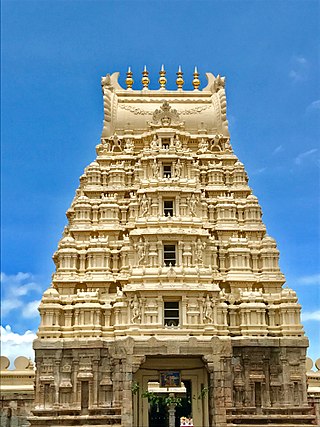
Srirangapatna is a town and headquarters of one of the seven Taluks of Mandya district, in the Indian State of Karnataka. It gets its name from the Ranganthaswamy temple consecrated around 984 CE. Later, under the British rule, the city was renamed to Seringapatam. Located near the city of Mandya, it is of religious, cultural and historic importance.
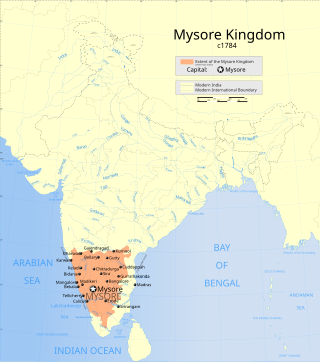
The Kingdom of Mysore was a geopolitical realm in southern India founded in around 1399 in the vicinity of the modern-day city of Mysore and prevailed until 1950. The territorial boundaries and the form of government transmuted substantially throughout the kingdom's lifetime. While originally a feudal vassal under the Vijayanagara Empire, it became a princely state in British India from 1799 to 1947, marked in-between by major political changes.

Chamarajendra Wadiyar X was the twenty-third Maharaja of Mysore between 1868 and 1894.

Mysore district, officially Mysuru district, is an administrative district located in the southern part of the state of Karnataka, India. It is the administrative headquarters of Mysore division. Chamarajanagar District was carved out of the original larger Mysore District in the year 1998. The district is bounded by Chamrajanagar district to the southeast, Mandya district to the east and northeast, Kerala state to the south, Kodagu district to the west, and Hassan district to the north.

Mysore pak is an Indian sweet prepared in ghee. It originated in the city of Mysore, one of the major cities in the Indian state of Karnataka. It is made of generous amounts of ghee, sugar, gram flour, and often cardamom. The texture of this sweet is similar to a buttery and dense cookie. It is also popular in the neighboring countries Pakistan and Bangladesh.

Kanteerava Narasimharaja Wadiyar was the heir apparent of the Kingdom of Mysore from 1895 until his death in 1940, during the reign of his brother, Maharaja Krishnaraja Wadiyar IV. Krishnaraja Wadiyar died less than six months after Narasimharaja Wadiyar did.
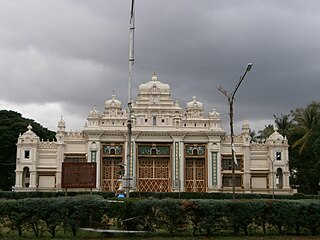
Sri Jayachamarajendra Art Gallery, commonly known by its former name Jaganmohana Palace, is a royal mansion, arts museum and auditorium, and formerly an alternative royal residence of the ruling maharaja of Mysore, located in Mysore, India, about 200m (600ft) to the west of Mysore Palace. Began in 1856 and completed in 1861, the palace is one of the oldest modern structures in Mysore.

The Kingdom of Mysore was a kingdom of southern India founded in 1399 by Yaduraya in the region of the modern city of Mysore. The Wodeyar dynasty, as the ruling family is known, ruled the southern Karnataka region until Indian independence in 1947, when the kingdom was merged with the Union of India.

The political history of the region on the Deccan Plateau in west-central peninsular India that was later divided into Mysore state and Coorg province saw many changes after the fall of the Hindu Vijayanagara Empire in 1565. The rise of Sultan Haidar Ali in 1761 introduced a new period.

Dadabhai Naoroji Road (D.N.Road), a North–South commercial artery road, in the Fort business district in South Mumbai of Maharashtra, India, is the nerve centre of the city, starting from the Mahatma Phule Market ,linking Chhatrapati Shivaji Maharaj Terminus, leads to the Hutatma Chowk at the southern end of the road. This entire stretch of the road is studded with Neo–Classical and Gothic Revival buildings and parks built in the 19th century, intermingled with modern office buildings and commercial establishments.

Mysuru City Corporation (MCC) is the administrative body responsible for civic amenities and infrastructural assets of Mysuru in Karnataka, India. It is the third-largest municipal corporation in Karnataka, serving a population of 1,000,000 in an area of 235 km2. The city's boundaries have expanded more than twice between 2010 and 2020.

St. Bartholomew's Church is an Anglican church, built by the Madras Government for the East India Company troops stationed in Kingdom of Mysore and is located in Lashkar Mohalla, on the Nilgiri Road, near the noisy Mysore sub-urban bus stand in Mysore City. The church grounds was consecrated on 29 November 1830 by Bishop Turner of Calcutta, (p. 327) and the building was completed in 1832. The church is named after Saint Bartholomew, one of the 12 apostles of Jesus Christ, and is said to have visited India in the first century AD, and preached the Christian gospel in the Kalyan, Thane and Raigad regions of present-day Maharashtra.

D. Devaraj Urs Road is the most prominent shopping street of Mysore city in Karnataka state, India. This street is also the center of the downtown or the Central business district area in the city. In post office parlance, Devaraj Urs road is known as Mysore One.

Dufferin Clock Tower is a historic relic and heritage structure of Mysore city in Karnataka province, India.
Nawab Mir Najaf Ali Khan is a grandson of the last Nizam of Hyderabad, Mir Osman Ali Khan and is a prominent figure known for heritage conservation, social initiatives, and legal representation of the Nizam's family.

Devaraja Market is a market located in Mysuru. One can buy flowers, fruits, and choose from conical piles of colorful Kumkum powder. Spices, sandalwood products, silk saris, essential oils, and incense are also available for purchase. The market is on Sayaji Rao Road. In 2017, there were 1,122 shops in the market employing over 3,000 people and receiving 8,000 to 10,000 visitors each day. It is a tourist attraction, and a popular place to take photos.
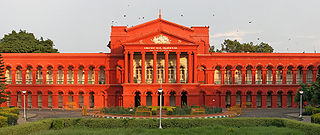
Attara Kacheri in Bangalore, India, is the seat of the principal bench of the Karnataka High Court, the highest judicial authority in the state of Karnataka. It is a neoclassical red-painted stone and brick building in Cubbon Park, located on Dr. B. R. Ambedkar Road opposite the Vidhana Soudha. It previously housed the secretariat of the princely state of Mysore and then that of independent India's Mysore State.
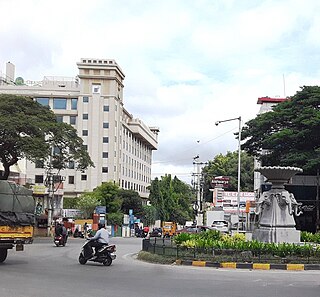
Sayyajirao Road, also known as Sayyaji Rao Road, is a road in Mysore, India stretching in the north from Agrahara circle at one end to Highway circle at the other. This road was named after Maharaja Sayajirao Gaekwad by Maharaja Chamaraja Wodayar X in 1893.
Lakshmipura is a suburb of Mysore city in Karnataka state, India.


















